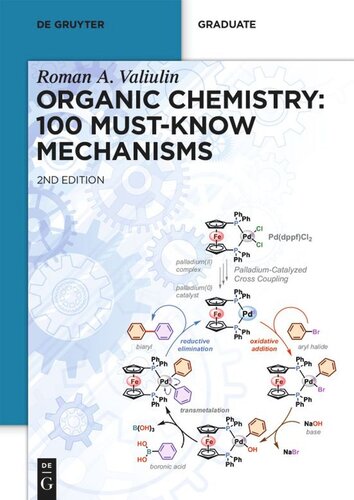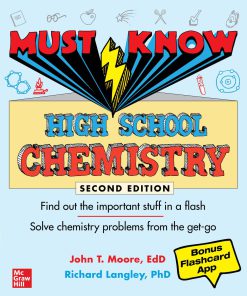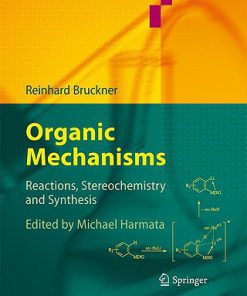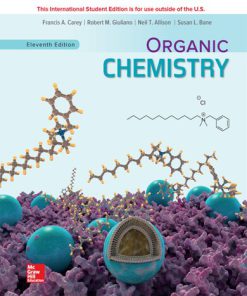Organic Chemistry 100 Must Know Mechanisms 1st edition by Roman Valiulin ISBN 3110608308 978-3110608304
$50.00 Original price was: $50.00.$25.00Current price is: $25.00.
Organic Chemistry 100 Must Know Mechanisms 1st edition by Roman Valiulin – Ebook PDF Instant Download/Delivery: 3110608308 978-3110608304
Full download Organic Chemistry 100 Must Know Mechanisms 1st edition after payment

Product details:
ISBN 10: 3110608308
ISBN 13: 978-3110608304
Author: Roman Valiulin
This book summarizes 100 essential mechanisms in organic chemistry ranging from classical such as the Reformatsky Reaction from 1887 to recently elucidated mechanism such as the copper(I)-catalyzed alkyne-azide cycloaddition. The reactions are easy to grasp, well-illustrated and underpinned with explanations and additional information.
Organic Chemistry 100 Must Know Mechanisms 1st Table of contents:
-
Introduction to Organic Mechanisms
- Overview of organic chemistry and reaction mechanisms
- The importance of understanding reaction mechanisms
- Key principles and terminology in organic mechanisms
-
Chapter 1: Nucleophilic Substitution Reactions (SN1 and SN2)
- Mechanisms of SN1 and SN2 reactions
- Factors affecting reaction rates
- Examples and applications of nucleophilic substitution
-
Chapter 2: Elimination Reactions (E1 and E2)
- E1 vs. E2 mechanisms
- Regioselectivity and stereochemistry in elimination reactions
- Examples of elimination reactions
-
Chapter 3: Addition Reactions
- Electrophilic addition to alkenes
- Hydrohalogenation, hydration, and halogenation
- Mechanisms for addition to alkynes
-
Chapter 4: Radical Reactions
- Radical initiation, propagation, and termination
- Radical halogenation and polymerization
- Mechanisms of radical reactions in organic chemistry
-
Chapter 5: Electrophilic Aromatic Substitution
- Mechanism of electrophilic aromatic substitution
- Common electrophiles in aromatic substitution
- Examples like nitration, sulfonation, Friedel-Crafts reactions
-
Chapter 6: Nucleophilic Addition Reactions
- Addition to carbonyl compounds (aldehydes, ketones)
- Mechanism of hydride and alkyl addition
- Examples in aldehyde and ketone chemistry
-
Chapter 7: Rearrangements and Other Reactions
- Mechanisms of common organic rearrangements (e.g., Wagner–Meerwein, Beckmann, etc.)
- Types of shift reactions and examples
- Intramolecular reactions and their mechanisms
-
Chapter 8: Pericyclic Reactions
- Mechanism of cycloaddition, electrocyclic, and sigmatropic rearrangements
- The Woodward-Hoffmann rules
- Examples like the Diels-Alder reaction
-
Chapter 9: Organometallic Reactions
- Mechanisms of reactions involving organometallic reagents (Grignard, lithium reagents)
- Cross-coupling reactions (e.g., Suzuki, Heck)
- Role of transition metals in reaction mechanisms
-
Chapter 10: Enzyme-Catalyzed Mechanisms
- Basics of enzyme-catalyzed reactions
- Mechanisms of enzyme activity
- Enzyme inhibitors and their roles
-
Chapter 11: Synthesis Strategies and Mechanisms
- Retrosynthesis and planning synthesis
- Key synthetic reactions and strategies
- How mechanisms guide synthetic pathways
-
Chapter 12: Conclusion: Connecting Mechanisms to Organic Synthesis
- How understanding mechanisms is crucial for successful organic synthesis
- Practical application of reaction mechanisms in laboratory work
-
Appendix: Reaction Mechanism Summary Tables
- Quick reference tables for common organic reaction mechanisms
- Important tips for remembering and applying mechanisms
People also search for Organic Chemistry 100 Must Know Mechanisms 1st:
roman a valiulin organic chemistry 100 must know mechanisms
organic chemistry 100 must know mechanisms pdf
organic chemistry 100 must know mechanisms pdf free
organic chemistry 100 must know mechanisms de gruyter textbook
organic chemistry facts
Tags:
Roman Valiulin,Organic Chemistry,Must Know Mechanisms
You may also like…
Chemistry - Inorganic Chemistry
Mathematics - Algebra
Must Know High School Algebra, 2nd Edition Christopher Monahan
Education Studies & Teaching - Teaching & Teacher Training
Chemistry - Organic Chemistry
Mathematics - Geometry and Topology
Chemistry - Organic Chemistry
Organic Reactions and Their Mechanisms, 2nd Edition V. K. Ahluwalia
Uncategorized
Chemistry - Organic Chemistry



![Organic Chemistry 2022 [Global TENTH Edition] LEROY. SIMEK WADE (JAN.), Jan Simek Organic Chemistry [Global Edition]](http://ebookmeta.com/wp-content/uploads/2024/05/organic-chemistry-2022-global-tenth-edition-leroy-simek-wade-jan-jan-simek-46538338-247x296.jpg)







